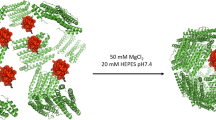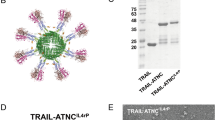Abstract
Because of the high biocompatibility, self-assembly capability, and CD71-mediated endocytosis, using human heavy chain ferritin (HFn) as a nanocarrier would greatly increase therapeutic effectiveness and reduce possible adverse events. Anti-PD-L1 siRNA can downregulate the level of PD-L1 on tumor cells, resulting in the activation of effector T cells against leukemia. Therefore, this study aimed to produce the tumor-targeting siPD-L1/HFn nanocarrier. Briefly, the HFn coding sequence was cloned into a pET-28a, and the constructed expression plasmid was subsequently transformed into E. coli BL21. After induction of Isopropyl β-d-1-thiogalactopyranoside (IPTG), HFn was purified with Ni-affinity chromatography and dialyzed against PBS. The protein characteristics were analyzed using SDS-PAGE, Western Blot, and Dynamic light scattering (DLS). The final concentration was assessed using the Bicinchoninic acid (BCA) assay. The encapsulation was performed using the standard pH system. The treatment effects of siPD-L1/HFn were carried out on HL-60 and K-562 cancer cell lines. The RT-PCR was used to determine the mRNA expression of PD-L1. The biocompatibility and excretion of siPD-L1/HFn have also been evaluated. The expression and purity of HFn were well verified through SDS-PAGE, WB, and DLS. RT-PCR analyses also showed significant siRNA-mediated PD-L1 silencing in both HL-60 and K-562 cells. Our study suggested a promising approach for siRNA delivery. This efficient delivery system can pave the way for the co-delivery of siRNAs and multiple chemotherapies to address the emerging needs of cancer combination therapy.



Similar content being viewed by others
Data availability
No datasets were generated or analysed during the current study.
References
Okazaki T, Honjo T. The PD-1–PD-L pathway in immunological tolerance. Trends Immunol. 2006;27(4):195–201.
de Miguel M, Calvo E. Clinical challenges of immune checkpoint inhibitors. Cancer Cell. 2020;38(3):326–33.
Burnett JC, Rossi JJ. RNA-based therapeutics: current progress and future prospects. Chem Biol. 2012;19(1):60–71.
Teo PY, et al. Ovarian cancer immunotherapy using PD-L1 siRNA targeted delivery from folic acid-functionalized polyethylenimine: strategies to enhance T cell killing. Adv Healthc Mater. 2015;4(8):1180–9.
Hobo W, et al. siRNA silencing of PD-L1 and PD-L2 on dendritic cells augments expansion and function of minor histocompatibility antigen-specific CD8+ T cells. Blood. 2010;116(22):4501–11.
Tatiparti K, et al. siRNA delivery strategies: a comprehensive review of recent developments. Nanomaterials. 2017;7(4):77.
Dong Y, Siegwart DJ, Anderson DG. Strategies, design, and chemistry in siRNA delivery systems. Adv Drug Deliv Rev. 2019;144:133–47.
Tu Z, et al. Ferritin-based drug delivery system for tumor therapy. BMEMat. 2023;1:e12022.
Pande A, et al. Expression of CD71 by flow cytometry in acute leukemias: more often seen in acute myeloid leukemia. Indian J Pathol Microbiol. 2016;59(3):310.
Khoshnejad M, et al. Ferritin-based drug delivery systems: hybrid nanocarriers for vascular immunotargeting. J Control Release. 2018;282:13–24.
Yuan Z, et al. Rational design of engineered H-ferritin nanoparticles with improved siRNA delivery efficacy across an in vitro model of the mouse BBB. Nanoscale. 2022;14(17):6449–64.
Wang Z, et al. Functional ferritin nanoparticles for biomedical applications. Front Chem Sci Eng. 2017;11:633–46.
Yang R, et al. Doxorubicin loaded ferritin nanoparticles for ferroptosis enhanced targeted killing of cancer cells. RSC Adv. 2019;9(49):28548–53.
Bellini M, et al. Protein nanocages for self-triggered nuclear delivery of DNA-targeted chemotherapeutics in cancer cells. J Control Release. 2014;196:184–96.
Wang F, et al. Iron and leukemia: new insights for future treatments. J Exp Clin Cancer Res. 2019;38:1–17.
Lebon D, et al. Hyperferritinemia at diagnosis predicts relapse and overall survival in younger AML patients with intermediate-risk cytogenetics. Leuk Res. 2015;39(8):818–21.
Benadiba J, et al. Iron chelation: an adjuvant therapy to target metabolism, growth and survival of murine PTEN-deficient T lymphoma and human T lymphoblastic leukemia/lymphoma. Leuk Lymphoma. 2017;58(6):1433–45.
Marsee DK, Pinkus GS, Yu H. CD71 (transferrin receptor) an effective marker for erythroid precursors in bone marrow biopsy specimens. Am J Clin Pathol. 2010;134(3):429–35.
Liu Q, et al. Significance of CD71 expression by flow cytometry in diagnosis of acute leukemia. Leuk Lymphoma. 2014;55(4):892–8.
Wei Y-Y, et al. Expression of CD71 on cell proliferation in hematologic malignancy and its correlation with Ki-67. Zhongguo Shi Yan Xue Ye Xue Za Zhi. 2015;23(1):234–40.
Zhao R, et al. PD-1/PD-L1 blockade rescue exhausted CD8+ T cells in gastrointestinal stromal tumours via the PI3K/Akt/mTOR signalling pathway. Cell Prolif. 2019;52(3):e12571.
Wei SC, Duffy CR, Allison JP. Fundamental mechanisms of immune checkpoint blockade therapy. Cancer Discov. 2018;8(9):1069–86.
Yang H, et al. Expression of PD-L1, PD-L2, PD-1 and CTLA4 in myelodysplastic syndromes is enhanced by treatment with hypomethylating agents. Leukemia. 2014;28(6):1280–8.
Fan K, et al. Magnetoferritin nanoparticles for targeting and visualizing tumour tissues. Nat Nanotechnol. 2012;7(7):459–64.
van Ens D, et al. PD-L1 siRNA-mediated silencing in acute myeloid leukemia enhances anti-leukemic T cell reactivity. Bone Marrow Transplant. 2020;55(12):2308–18.
Acknowledgements
Not applicable
Funding
This research was supported by Mazandaran University of Medical Science (Grant number 10600).
Author information
Authors and Affiliations
Contributions
HA-O conceived and supervised the study and editted the final manuscript. MR conducted the experiments, analyzed the data, and wrote the manuscript. RV and MT designed the experiments. AN helped with the cloning, and MS and RN helped with the DLS optimization. All authors reviewed the results and approved the final version of the manuscript.
Corresponding author
Ethics declarations
Conflict of interest
The authors declare the lack of commercial or financial relationships that could be construed as a potential conflict of interest.
Ethical approval
This article contains no studies with human participants and is approved by the Ethical Committee with the number (IR.MAZUMS.REC.1400.633).
Additional information
Publisher's Note
Springer Nature remains neutral with regard to jurisdictional claims in published maps and institutional affiliations.
Rights and permissions
Springer Nature or its licensor (e.g. a society or other partner) holds exclusive rights to this article under a publishing agreement with the author(s) or other rightsholder(s); author self-archiving of the accepted manuscript version of this article is solely governed by the terms of such publishing agreement and applicable law.
About this article
Cite this article
Rajabinejad, M., Valadan, R., Tehrani, M. et al. Effective delivery of anti-PD-L1 siRNA with human heavy chain ferritin (HFn) in acute myeloid leukemia cell lines. Med Oncol 41, 149 (2024). https://doi.org/10.1007/s12032-024-02393-7
Received:
Accepted:
Published:
DOI: https://doi.org/10.1007/s12032-024-02393-7




